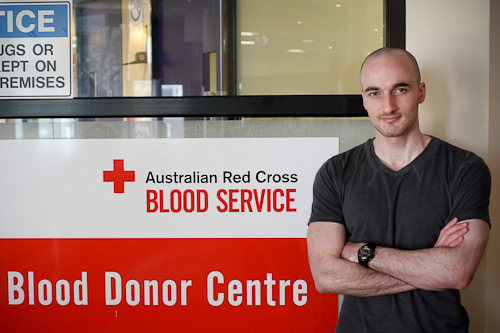Seeing Red: A gift from the heart
THEY gave me some light snacks and refreshments, but I had to pay for it in blood.
I’m at the Bourke Street Red Cross donation centre, and I’m here to make my twenty-first blood donation. But it’s my first time donating at Bourke Street – and I soon find out it’s a busy office. I’d phoned in my appointment for 2.05pm; it’s 2.08 and I feel a twinge of guilt for my habitual lateness as I present myself at the front desk. But I’m greeted with smiles, welcomes and thanks.
There’s a bit of paperwork to start things off (isn’t there always?), but since it’s not my first donation and I’ve got a donor card, the questionnaire is short and easy. Yes, I’m feeling fit and well. No, I haven’t had any tattoos lately and I don’t think I’m pregnant. While I’m ticking boxes, a young man comes in and asks if he can make a donation without having an appointment, and the nurse tells him they’re just too booked out. He says he’ll make an appointment for another time and turns to leave, and I’m left with the strange thought of a donation being turned down.
But make no mistake – there’s always a need for more blood donations, and as I find out later, more plasma and platelets. The nurses just have their hands too full to take an unexpected donation today.
A nurse takes a tiny blood sample from my finger while we do a safety check: blood pressure fine, haemoglobin fine, I’ve had plenty of water and my date of birth’s still the same (I do have to prove I’m not an imposter). My blood type is O positive. I chat with one of the nurses while they prepare me for the main donation, and I find out about donating whole plasma – apparently it’s in even more demand than blood at the moment, and it can be donated more frequently. If you’re only donating plasma, you retain your red blood cells and can give another plasma donation as quickly as two weeks later.
There are many reasons people don’t donate blood, and even though I barely feel a thing as the needle gently goes into my arm, I can understand them. It can be scary for some, or gruesome to even think about for others. Everything from the sight, feeling and thought of donating blood can make some people feel faint. On the other hand (I think to myself, as I grip a squeezy-ball in my hand), like any fear, it is something you get can used to and even overcome. And although I can’t see for myself what happens to the blood – after it flows down a tube, into a bag and goes from there to the unknown – I know the stats say someone’s very life might depend on receiving it.
Some time is taken out of my day; a pinprick hurts my skin; and some ancient instinct in the base of my brainstem raises a primitive objection that is soon forgotten. These are the tiny prices for me to pay. Is this really all I need to sacrifice to save a life? Before I can even comprehend this question, 470 millilitres of blood have been taken, and the machine stops. The needle is replaced by a bandage on my arm, and I stand up and don’t feel any different. No faintness, no dizziness. I feel fine.
I’m told that for people high in iron, losing a bit of blood even acts as a health boost by taking the iron down to healthier levels.
There’s a refreshment area with tables, chairs, newspapers. I get a complimentary drink and snack of my choice, and the room is quiet and peaceful. After I’m done rehydrating, I feel ready to move on. Refreshed, even. Better.
So, looking back: am I glad I’ve given blood? Oh, positive.
Are you eligible to donate blood? Many overseas students might assume that travelling prevents them from making blood donations. They might be right, and they might be wrong! The only way to find out for sure is to check.
Visit www.donateblood.com.au, where you can read a blood donation FAQ, check your eligibility or find out more by calling 13 14 95.





